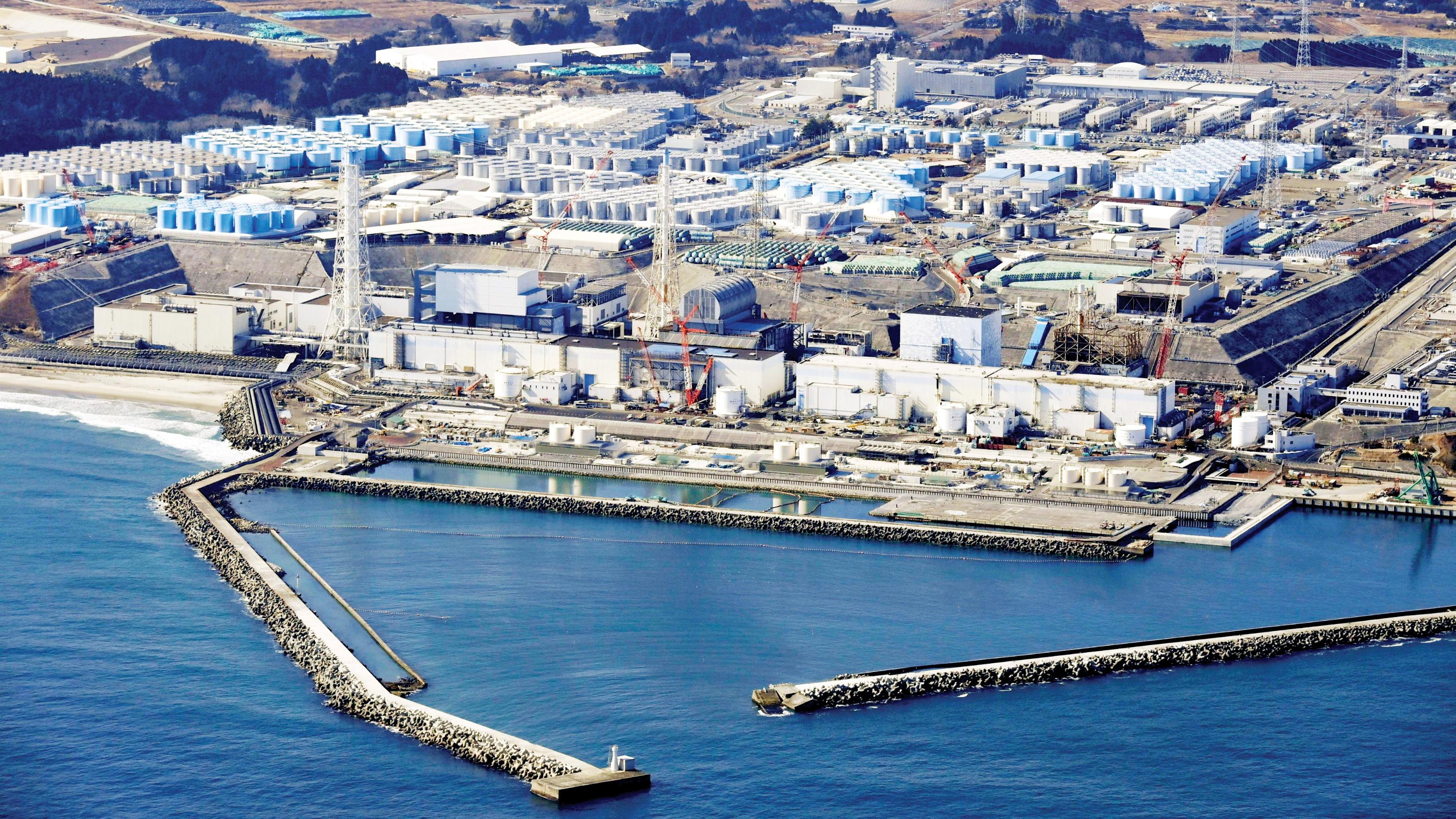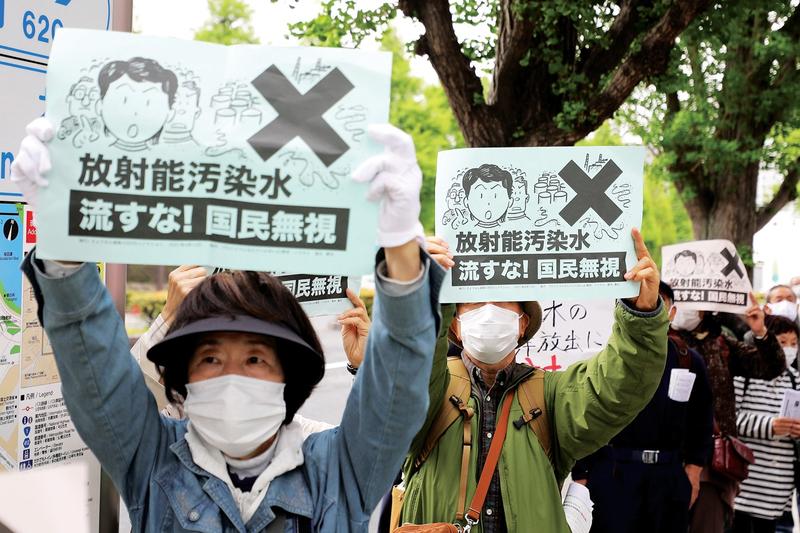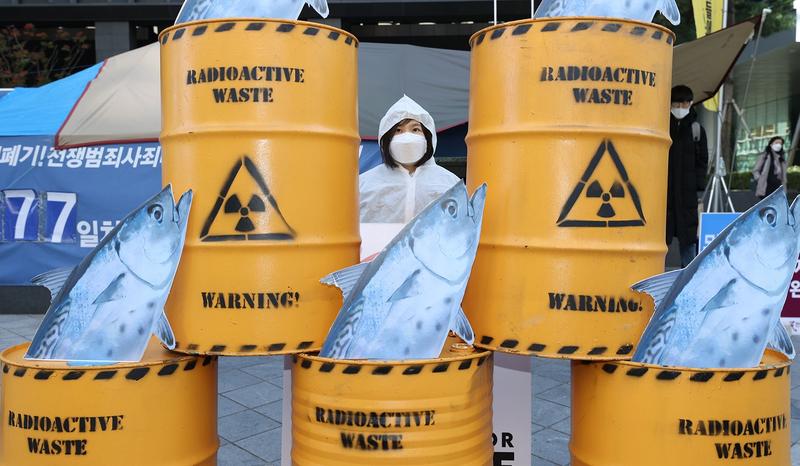 Storage tanks hold treated water at the Fukushima Daiichi nuclear power plant in Okuma, Fukushima prefecture, Japan, as seen on April 13, 2021. (KYODO NEWS VIA AP)
Storage tanks hold treated water at the Fukushima Daiichi nuclear power plant in Okuma, Fukushima prefecture, Japan, as seen on April 13, 2021. (KYODO NEWS VIA AP)
For the past week, Hisae Unuma has been traveling from Saitama Prefecture, outside Tokyo, to the heart of the metropolis in Shinjuku, the world’s busiest railway station, where he has been handing out leaflets to passersby every day.
Boldly proclaiming “Protect children from exposure to radiation” in Japanese, the fliers are a key element of a campaign by Unuma to provoke stronger calls among ordinary Japanese for the government to scrap a decision to dump contaminated water from the crippled Fukushima Daiichi nuclear power plant into the ocean.
“The government kept promising reconstruction of my hometown Fukushima in the past decade, but dumping the water seems contrary to that pledge because it threatens a double blow to our community,” said Unuma, who was among the 160,000 residents evacuated from the region following an earthquake and tsunami disaster in March 2011.
Living 3 kilometers from the Fukushima nuclear power plant, Unuma was moved to the city of Kasu in Saitama Prefecture after the disaster.
“Eleven years have passed and my home remains in a dilapidated condition. The way back home is too difficult,” he said.
April 13 marked a year since Japan announced the plan to release more than 1.3 million metric tons of treated but still radioactive water into the ocean, and Unuma and fellow campaigners had sought to stage a protest on that day outside Japan’s parliament.
A year after the announcement was made, governments, environmental groups and experts around the world remain vocal, pressuring Japan to use a safer alternative to discharging the contaminated water.
South Korean lawmaker Seo Sam-seok said in an April 11 forum that the discharge “will spread across the entire Pacific Ocean in 10 years and affect almost all of our sea,” according to a report filed by Xinhua.
A Chinese Foreign Ministry spokesperson, Zhao Lijian, said during an April 13 press briefing that China is “seriously concerned with and resolutelly oppose” the unilateral decision of Japan.
The Pacific Islands Forum, or PIF, which is comprised of 18 countries, appointed in March an independent panel of global experts on nuclear issues, to provide independent technical advice to the PIF in its ongoing dialogue with Japan on the Fukushima wastewater.
PIF Secretary General Henry Puna said in a statement that the forum’s “ultimate goal is to safeguard the Blue Pacific — our ocean, our environment, and our peoples — from any further nuclear contamination. This is the legacy we must leave for our children.”
Tilman Ruff, a Nobel Peace Prize Laureate and co-president of International Physicians for the Prevention of Nuclear War, or IPPNW, said the concerns voiced by Japan’s neighboring countries are “justified”, noting the “significant amount of radioactivity” involved in the Fukushima wastewater.
“All radioactivity has harmful health consequences for all living things, not just humans. Once (the contaminated water is) released into the ocean, they will be minutely distributed with the ocean current and they will find their way into the food chain,” Ruff said in an interview with China Daily.
He said every increase in radiation “poses some level of risk. There’s no level below which you can say there’s no effect.” Children and women are more vulnerable to the ill effects of radiation.
“Children are three to five times more sensitive to the long-term cancer-inducing effects of a given dose of radiation than adults. Women and girls are about 40 percent more susceptible to cancer induction than males from a given dose of radiation,” Ruff said.
He said there are “reasonable alternatives” to dumping wastewater into the ocean. One option is to contain it in a land-based storage.
Environmental group Greenpeace said the “most acceptable solution” is to continue long-term storage and processing of the contaminated water at its original site, rather than releasing it to the ocean.
 Japanese protest in Tokyo in April 2021 over their government’s discharge plan. The release of the toxic water will begin in spring 2023. (DU XIAOYI / XINHUA)
Japanese protest in Tokyo in April 2021 over their government’s discharge plan. The release of the toxic water will begin in spring 2023. (DU XIAOYI / XINHUA)
‘Learned nothing’
Northern Mariana Islands, a US territory that is located some 2,500 kilometers southeast of Japan, said it supports Greenpeace’s proposal. The territory has adopted a joint resolution opposing moves by any nation to dispose of nuclear waste in the Pacific Ocean.
Renato Redentor Constantino, executive director of the Manila-based Institute for Climate and Sustainable Cities think tank, said Japan’s decision to dump wastewater despite its potentially harmful impact on its neighbors has shown that Japan “has learned nothing” from its history.
“The stain of shame is twice layered on Japan. First, the obscenity of dumping on innocent lives the folly of its refusal to leave behind its deadly embrace of nuclear energy. Second, because it has learned nothing despite having been a victim of nuclear dumping through the Hiroshima and Nagasaki bombs,” Constantino told
China Daily.
Despite widespread condemnation at home and abroad, policymakers in Japan have shown no sign they are considering any reversal of the plan.
In late March, civil society groups in the most affected Japanese prefectures submitted a petition to the nation’s Ministry of Economy, Trade and Industry and Tokyo Electric Power Company, or TEPCO, the Fukushima plant’s operator.
Reaffirming their opposition to the release of the contaminated water, they are demanding that the government pursue other alternatives. Consumer groups and fisheries associations are at the forefront of this action.
Katsuhito Fuyuki, the board chairperson of the Miyagi Consumers Cooperative Association, said the government’s disposal plan has failed to win support from the people.
“The impact of the 2011 nuclear accident remains, and imports of Miyagi fishery products are still banned by nearby countries,” said Fuyuki, adding that the wastewater discharge decision will deal a further blow to the local economy.
Under the government’s plan, the authorities will gradually discharge the still-contaminated water from spring 2023. In all, the release would be sufficient to fill about 500 Olympic-sized swimming pools.
The water has been used to cool highly radioactive damaged reactor cores as the massive earthquake and tsunami destroyed the Fukushima plant’s cooling systems, triggering the meltdown of three reactors and the release of large amounts of radiation.
Japan has insisted that there are no alternatives to the ocean discharge. It said that by the end of 2022 there will be no space left for storage. Moreover, after a treatment process known as the Advanced Liquid Processing System, or ALPS, the radioactive tritium — a radioactive isotope of hydrogen — will be the only radionuclide in the water and that it is harmless.
However, many environmental scientists and environmentalists are scathing in their condemnation of Japan’s narrative, saying it is misinformation aimed at creating a false impression that the consequences of the 2011 nuclear disaster are short-lived.
A report in 2020 by Greenpeace said the narrative has been constructed to serve financial and political reasons.
“Long after the Yoshihide Suga (and Shinzo Abe) administrations are historical footnotes, the negative consequences of the Fukushima Daiichi meltdown will remain a present and constant threat — most immediately to the people and environment of Fukushima, but also to the rest of Japan and internationally,” said the report, referring to Suga as the then prime minister whose government approved the disposal plan a year ago.
According to the Greenpeace report, there is no technical, engineering or legal barrier to securing storage space for ALPS-treated contaminated water. It is only a matter of political will.
The report also took aim at ALPS, describing it as a flawed technology because of its poor performance and inability to remove Carbon-14, a long-term radiological hazard with a half-life of 5,730 years.
Kenichi Oshima, a professor in policy science at Ryukoku University in Kyoto, said another claim that amounts to a false narrative is TEPCO’s statement that it plans to decommission the Fukushima reactor in 30 years.
“Their logic is, in order to decommission the reactors in 30 years, they have to discharge the water now. This is totally unacceptable because the goal itself is a mission impossible,” Oshima said. “Building on this false assumption, all the process behind it will be problematic.
“The Japanese government has a duty to let people know about the facts of the Fukushima Daiichi nuclear power plant but they failed to do so and they covered up the truth.”
 A demonstration outside the Japanese embassy in Seoul in 2020 highlights South Koreans' fears for the consequences of the Japanese government's plan. (PHOTO / YONHAP)
A demonstration outside the Japanese embassy in Seoul in 2020 highlights South Koreans' fears for the consequences of the Japanese government's plan. (PHOTO / YONHAP)
The decommissioning of a nuclear reactor involves removing the used nuclear fuel from the reactor, placing it into the used fuel pool, and eventually into dry storage containers. The first stage, the so-called final shutdown and preservation stage, could take a decade to complete.
As for Carbon-14, which can reach into communities in Japan and abroad for many generations due to its long half-life, Greenpeace said the dangers of it are being ignored by the Japanese government and that it has the potential to damage the structure of human DNA.
Taking a similar view are three United Nations human rights experts, Marcos Orellana, Michael Fakhri and David Boyd, who said in a joint statement that the water may contain quantities of Carbon-14 and other radioactive isotopes. Discharging the tainted water into the Pacific Ocean will threaten the health of people and the planet.
“Japan has noted that the levels of tritium are very low and do not pose a threat to human health. However, scientists warn that the tritium in the water organically binds to other molecules, moving up the food chain affecting plants and fish and humans,” the experts said in their report.
They said the radioactive hazards of tritium have been underestimated and could pose risks to humans and the environment for over 100 years.
“We remind Japan of its international obligations to prevent exposure to hazardous substances, to conduct environmental impact assessments of the risks that the discharge of water may have, to prevent trans-boundary environmental harms, and to protect the marine environment,” the experts said.
In a country well versed in public relations and branding, the Japanese government was quick to employ inventive ways in a bid to gather support for the ocean disposal.
Days after it announced the discharge plan, Japan’s Reconstruction Agency released a video depicting tritium as a “cute character” in an effort to dispel concerns about the radioactive substance and sweeten the government’s message.
Within a day, the tadpole-like character was scrapped and an apology issued after a wave of criticism on social media as well as in Japan’s parliament.
“If the government thinks it can get the general public to understand just by creating a cute character, it is making a mockery of risk communication,” Riken Komatsu, a writer involved in reconstruction activities in Iwaki, Fukushima, said on Twitter.
Sticking to the message, the national government busied itself organizing expert panels to explain the policy to communities. The efforts fell flat and only made the situation worse.
A China Daily investigation found that 41 of Fukushima prefecture’s 59 municipal councils oppose the disposal plan, with 25 of them strongly opposing it.
A report ordered by Japan’s parliament into the Fukushima nuclear disaster said that TEPCO’s corporate culture was to blame for the accident, citing misplaced deference and reluctance to question authority within the company as the root causes, in addition to many other factors.
Cover-up accusations
Yet, a sequence of events that occurred after the accident has raised fears as to whether the company has truly changed. Many question why the government still relies on TEPCO to deal with the consequences of the disaster, given the repeated accusations of cover-ups and delayed disclosure leveled at the utility.
In January 2021, at the Kashiwazaki-Kariwa nuclear power station, another plant owned by TEPCO, it was proved that the company had lied about having completed safety work on one of the plant’s reactors.
And the list could go further.
“It is safe to say that credibility is the key issue,” said Liu Qingbin, a professor at the Institute of Advanced Sciences at Yokohama National University.
According to Liu, even if the disposal plan was deemed perfect in theory, there is no guarantee that TEPCO and the Japanese government could deliver 100 percent safe treatment because all the events put together had “demolished Japan’s reputation for craftsmanship”.
As the Japanese government owns the majority stake in TEPCO, via the Nuclear Damage Compensation and Decommissioning Facilitation Corporation, the company’s integrity matters to the Japanese government and its financial performance matters to Japan’s public purse.
Japan’s unilateral decision a year ago provoked an immediate outcry from neighboring countries and Pacific Island communities.
At the time, China’s foreign ministry condemned Japan for making the decision without proper consultation with the affected countries, calling Tokyo highly irresponsible and stressing that the Pacific Ocean is not Japan’s “trash can”.
In a recent news conference, Chinese Foreign Ministry spokesman Wang Wenbin said: “We hope the Japanese side will not turn a deaf ear to all parties’ concerns and the public opinion at home.
“We urge Japan to revoke the erroneous decision of ocean discharge, conduct thorough consultation with stakeholders and relevant international organizations, and carefully assess the benefits and drawbacks of all disposal plans before making any decision, so as to ensure the safe disposal of nuclear-contaminated water.”
In response to the sustained pressure, the Japanese government invited two task forces from the International Atomic Energy Agency to conduct missions in Japan, in February and March, to review its dumping proposal.
The findings could come anytime soon, though the IAEA says a comprehensive report containing the overall conclusions of its task forces “will be published before any treated water is released”.
Ruff, the IPPNW co-president, said there is a general norm that “radioactive wastes should not be dumped indiscriminately into the ocean and into places where they’re not contained and can’t be properly monitored and managed”.
Japan’s claim that it has run out of space to store the wastewater “is just a red herring”, he said, noting that “there is actually quite a lot of land around the site that could be (utilized) for expanded storage facilities”.
Contact the writers at wangxu@chinadaily.com.cn


